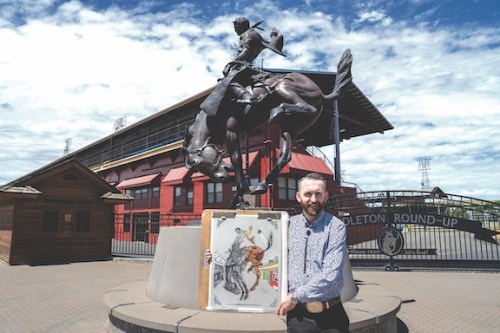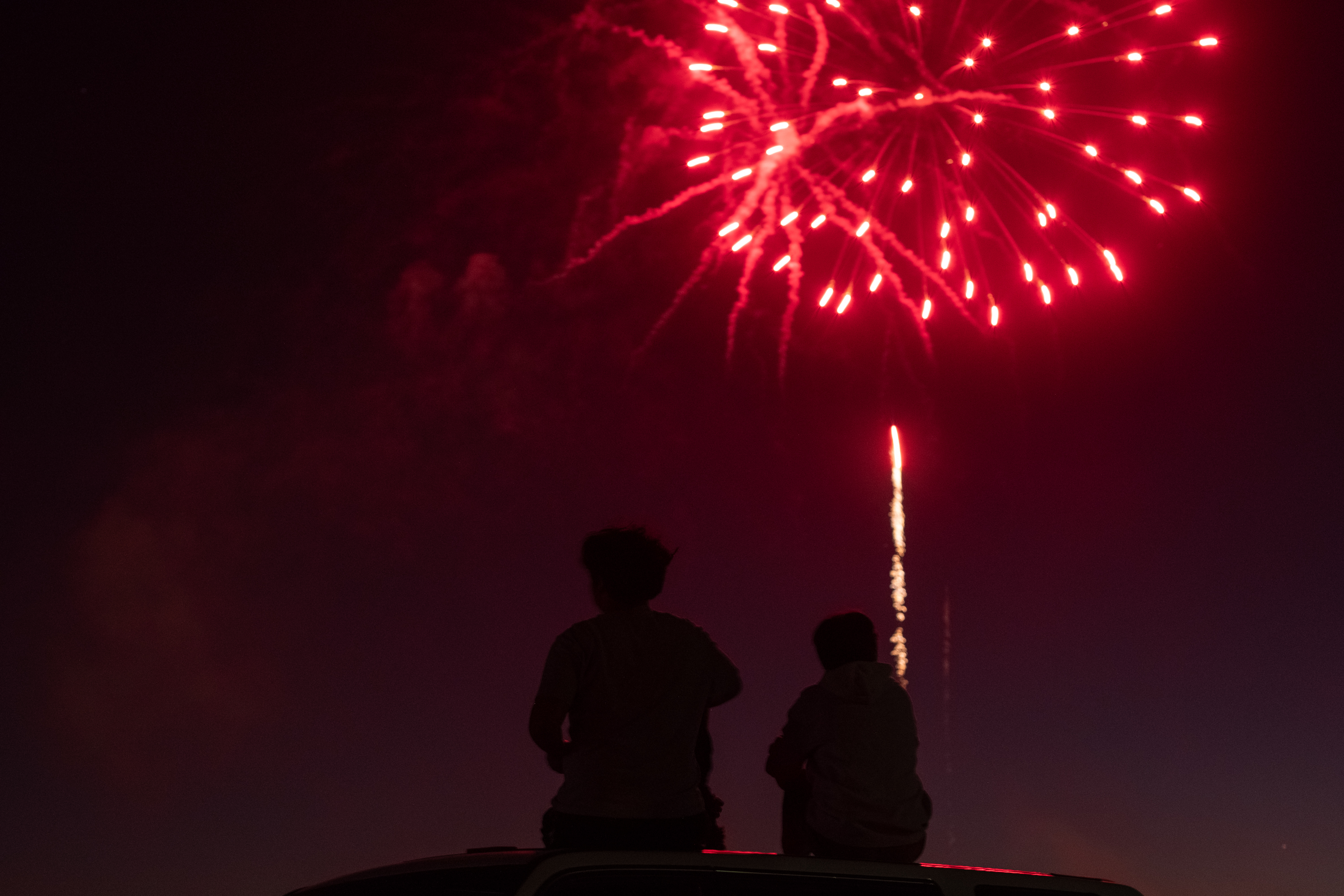From black and white to screaming color
Published 5:00 am Wednesday, June 18, 2025

- Markus McFetridge, of Pendleton, stands with his centennial bucking horse Pendleton Round-Up poster May 29, 2025, after winning the rodeo's second poster contest. Wallace Smith, the artist who created the original Round-Up poster, inspired McFetridge, as did the rodeo's rich past and bright future. (Berit Thorson/East Oregonian)
Local artist wins the Pendleton Round-Up’s poster competition
PENDLETON — One hundred years after the iconic Pendleton Round-Up bucking horse image became the rodeo’s logo, a local artist honored its legacy with his detailed design.
Markus McFetridge, mural painter and co-owner of Pendleton’s Flying X Speakeasy Lounge, won the Pendleton Round-Up Association’s second annual poster competition. His poster puts the bucking horse design front and center as a way to honor the original artist, Wallace Smith, after 100 years.
The image transitions from black and white on the left side to color on the right, representing the past and present of the Round-Up. McFetridge was one of more than 50 initial applicants and 10 finalists, competing with artists from Minnesota, Kansas, Arkansas, Idaho, California, Oklahoma, Washington and two others from Pendleton.
Trending
“He was going up against some really great people,” said Pendleton Round-Up General Manager Erika Patton. “His insight to the Round-Up, but also just the detail in his work, is so phenomenal.”
The past
When creating the piece, McFetridge pulled inspiration from the original bucking horse design.
“I was just trying to copy Wallace Smith and put myself in his shoes,” he said.
McFetridge used paper similar to Smith’s, and did the left half of the poster in charcoal, with the right half in chalk pastels. The viewer is seeing the arena from the east.
The left half, which generally depicts the southern side of the arena, features the stadium stands of decades past. Prior to a fire in 1940, the grandstand had “Pendleton” printed around its roof, which McFetridge included on the poster. He pulled the lettering style from a photo of his husband’s ancestor, who competed in Round-Up during its first few decades.
Peeking out from behind the grandstand are teepees from the Indian Village, which has been part of Round-Up from nearly the beginning. Along the poster’s bottom edge is a small line of grass to reference Round-Up’s grass arena.
Trending
Each of the corners also features a filigree, which McFetridge said is an homage to all the makers and craftsmen involved in the Round-Up. The specific design of the filigree is based on his husband’s grandfather’s 1930s saddle.
“I think for me it just felt really special and urgent and important to draw back to the past and give a light to something that hasn’t had that spotlight,” McFetridge said.
The present
While the left half honors history, the right is all about the Round-Up of today.
The filigrees now have shades of yellow edging them, and there’s a jet flying overhead. Instead of shades of black and white filling the stands, dots of red, orange, blue, pink and green represent the tens of thousands of fans who attend each year.
The grass is suddenly green, and the horse and cowboy are toned in yellows, reds and browns. McFetridge said he used around seven shades of brown for the horse.
The arena’s iconic hand-painted bucking chutes appear almost technicolor compared to the shaded charcoal wood barrier of Round-Ups past. McFetridge said with the old grandstand on the south and the bucking chutes on the north, “it was perfect to transition from black and white to color” on his design.
It took McFetridge about 50 hours during two or three weeks to make the poster. He used an application on his phone to record and track himself tracing the bucking horse from a projection onto his ipad, then copied his arm movements to draw the horse on the final sheet of paper.
“I usually just go like that and then just get the outline done, and that gives me enough to have the proportions,” he said. “Then I just freehand the rest.”
Calling it freehanded may be an understatement, however. McFetridge said he had a line splitting it exactly in half vertically and he measured each aspect of the poster out from that middle line to ensure it was perfectly even.
Focusing on the small details was important to McFetridge, he said, because he knew his overall design looks simple at first glance. But McFetridge has painted murals in his professional life, including two in the entrance to the Pendleton Walmart.
“I think I’ve grown and learned a lot through my murals and doing that to be able to pull this off,” he said. “It helped with really thinking of the concept too, of using all of that different influence of murals and having to sell myself to engage with the customer has helped me be able to figure this out.”
Painting for commercial audiences showed him that people need something central to draw their eye first before noticing the intricate, smaller details. The bucking horse was the perfect centerpiece, he said, especially given its centennial anniversary being this year.
“I think it’s so cool to be able to leave my legacy for Pendleton and put my name in history and stamp it a hundred years later,” said McFetridge.
McFetridge’s husband, Tim, said it means a lot to see his husband involved in Round-Up in such a significant way. The couple are just “being who we are,” Tim said, and focusing on “community love and personal love and giving back.”
The McFetridges prefer to focus less on their identities and more on the work they do in the community. Still, though, Markus being recognized and celebrated by such a popular rodeo matters because it’s a form of inclusion and representation.
Rodeo culture broadly hasn’t historically been inclusive of queer people, though there is a well-established gay rodeo circuit across the country, open to all to participate. The couple works tightly with their community, including the rodeo and equine industry abroad. They said they want everyone to be celebrated for who they are, regardless of identity.
The future
While the Pendleton Round-Up has only had its poster competition for two years, the association has previously commissioned artists to make annual posters.
Patton said starting the competition was a way to cultivate newer talent that hadn’t had an opportunity on such a large scale before. This year, winning came with prize money of $5,000.
“I think where we’re challenged more than anything is getting the people who don’t win to resubmit the following year,” Patton said. “There’s been ones that were like, ‘It just didn’t fit this year, but it doesn’t mean it couldn’t.’”
She said she hopes at some point to increase the award and give money to the top three posters, which is what the Calgary Stampede does with its youth poster competition. The Stampede was an inspiration to Patton and Round-Up marketing coordinator Mikal Wright, the pair who established Pendleton’s contest.
For now, though, the competition is smaller. But that doesn’t mean the $5,000 won’t help McFetridge, who said he plans to use the money to help pay down his student loans from art school and to pay for art supplies for future projects.
“I just want to paint and draw for the rest of my life. That’s it,” said McFetridge. “If I could do that as my job, that would be surreal.”









